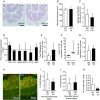Properties of myenteric neurones and mucosal functions in the distal colon of diet-induced obese mice
- PMID: 23940384
- PMCID: PMC3810814
- DOI: 10.1113/jphysiol.2013.262733
Properties of myenteric neurones and mucosal functions in the distal colon of diet-induced obese mice
Abstract
Colonic transit and mucosal integrity are believed to be impaired in obesity. However, a comprehensive assessment of altered colonic functions, inflammatory changes and neuronal signalling of obese animals is missing. In mice, we studied the impact of diet-induced obesity (DIO) on: (i) in vivo colonic transit; (ii) signalling in the myenteric plexus by recording responses to nicotine and 2-methyl-5-hydroxytryptamine (2-methyl-5-HT), together with the expression of tryptophan hydroxylase (TPH) 1 and 2, serotonin reuptake transporter, choline acetyltransferase and the paired box gene 4; and (iii) expression of proinflammatory cytokines, epithelial permeability and density of macrophages, mast cells and enterochromaffin cells. Compared with controls, colon transit and neuronal sensitivity to nicotine and 2-methyl-5-HT were enhanced in DIO mice fed for 12 weeks. This was associated with increased tissue acetylcholine and 5-hydroxytryptamine (5-HT) content, and increased expression of TPH1 and TPH2. In DIO mice, upregulation of proinflammatory cytokines was found in fat tissue, but not in the gut wall. Accordingly, mucosal permeability or integrity was unaltered without signs of immune cell infiltration in the gut wall. Body weight showed positive correlations with adipocyte markers, tissue levels of 5-HT and acetylcholine, and the degree of neuronal sensitization. DIO mice fed for 4 weeks showed no neuronal sensitization, had no signs of gut wall inflammation and showed a smaller increase in leptin, interleukin-6 and monocyte chemoattractant protein 1 expression in fat tissue. DIO is associated with faster colonic transit and impacts on acetylcholine and 5-HT metabolism with enhanced responsiveness of enteric neurones to both mediators after 12 weeks of feeding. Our study demonstrates neuronal plasticity in DIO prior to the development of a pathological histology or abnormal mucosal functions. This questions the common assumption that increased mucosal inflammation and permeability initiate functional disorders in obesity.
Figures






Comment in
-
Obesity and plasticity: how your gut learns to deal with your diet.J Physiol. 2013 Oct 15;591(20):4955. doi: 10.1113/jphysiol.2013.264085. J Physiol. 2013. PMID: 24130319 Free PMC article. No abstract available.
Similar articles
-
Essential roles of enteric neuronal serotonin in gastrointestinal motility and the development/survival of enteric dopaminergic neurons.J Neurosci. 2011 Jun 15;31(24):8998-9009. doi: 10.1523/JNEUROSCI.6684-10.2011. J Neurosci. 2011. PMID: 21677183 Free PMC article.
-
Pharmacological reduction of mucosal but not neuronal serotonin opposes inflammation in mouse intestine.Gut. 2014 Jun;63(6):928-37. doi: 10.1136/gutjnl-2013-304901. Epub 2013 Jun 7. Gut. 2014. PMID: 23749550 Free PMC article.
-
Hyperinsulinemia-induced upregulation of adipocyte TPH2 contributes to peripheral serotonin production, metabolic dysfunction, and obesity.J Clin Invest. 2025 May 30;135(14):e190765. doi: 10.1172/JCI190765. eCollection 2025 Jul 15. J Clin Invest. 2025. PMID: 40455408 Free PMC article.
-
Gut Barrier Proteins Mediate Liver Regulation by the Effects of Serotonin on the Non-Alcoholic Fatty Liver Disease.Curr Protein Pept Sci. 2020;21(10):978-984. doi: 10.2174/1389203721666200615171928. Curr Protein Pept Sci. 2020. PMID: 32538722 Review.
-
5-Hydroxytryptamine (serotonin) in the gastrointestinal tract.Curr Opin Endocrinol Diabetes Obes. 2013 Feb;20(1):14-21. doi: 10.1097/MED.0b013e32835bc703. Curr Opin Endocrinol Diabetes Obes. 2013. PMID: 23222853 Free PMC article. Review.
Cited by
-
Gut microbes promote colonic serotonin production through an effect of short-chain fatty acids on enterochromaffin cells.FASEB J. 2015 Apr;29(4):1395-403. doi: 10.1096/fj.14-259598. Epub 2014 Dec 30. FASEB J. 2015. PMID: 25550456 Free PMC article.
-
Nutrient-induced changes in the phenotype and function of the enteric nervous system.J Physiol. 2014 Jul 15;592(14):2959-65. doi: 10.1113/jphysiol.2014.272948. Epub 2014 Jun 6. J Physiol. 2014. PMID: 24907307 Free PMC article. Review.
-
Molecular Characterization of Constipation Disease as Novel Phenotypes in CRISPR-Cas9-Generated Leptin Knockout Mice with Obesity.Int J Mol Sci. 2020 Dec 12;21(24):9464. doi: 10.3390/ijms21249464. Int J Mol Sci. 2020. PMID: 33322729 Free PMC article.
-
Poststroke emotional disturbances and a tryptophan hydroxylase 2 gene polymorphism.Brain Behav. 2018 Jan 11;8(2):e00892. doi: 10.1002/brb3.892. eCollection 2018 Feb. Brain Behav. 2018. PMID: 29484259 Free PMC article.
-
Gut Microbes and Health: A Focus on the Mechanisms Linking Microbes, Obesity, and Related Disorders.Obesity (Silver Spring). 2018 May;26(5):792-800. doi: 10.1002/oby.22175. Obesity (Silver Spring). 2018. PMID: 29687645 Free PMC article. Review.
References
-
- Bertrand R, Senadheera S, Markus I, Liu L, Howitt L, Chen H, Murphy TV, Sandow SL, Bertrand PP. A Western Diet increases serotonin availability in rat small intestine. Endocrinology. 2011;152:36–47. - PubMed
-
- Bertrand RL, Senadheera S, Tanoto A, Tan KL, Howitt L, Chen H, Murphy TV, Sandow SL, Liu L, Bertrand PP. Serotonin availability in rat colon is reduced during a Western diet model of obesity. Am J Physiol Gastrointest Liver Physiol. 2012;303:G424–G434. - PubMed
-
- Bogumil R, Koal T, Weinberger KM, Dammeier S. Massenspektrometrische Analyse von Blutplasma im Kitformat. Laborwelt. 2008;2:17–23.
Publication types
MeSH terms
Substances
LinkOut - more resources
Full Text Sources
Other Literature Sources
Medical
Research Materials

